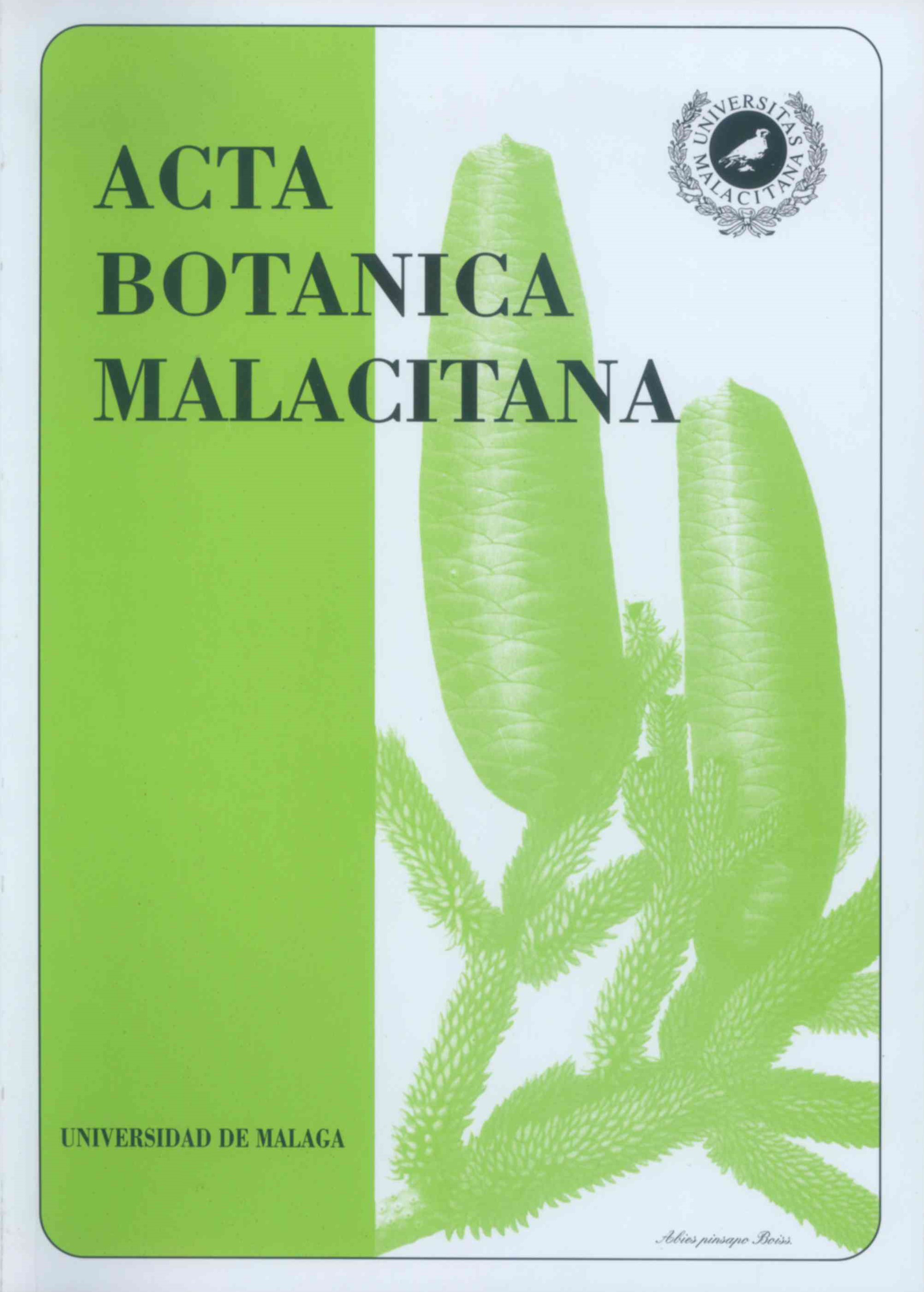Analysis of the summer airborne pollen contera in the province of Malaga
DOI:
https://doi.org/10.24310/abm.v26i0.7402Keywords:
aerobiology, summer, tourism, allergy, Malaga, southern Spain, pollenAbstract
In this work, a study about the atmospheric pollen content during the period July-September has been carried out in the province of Malaga. The study was made taking the data obtained during the last years in several localities of the province: Malaga (1992-1999), Estepona (1995-1997), Antequera (1998-1999) and Nerja (2000). In general, just between 3 and 6% of the annual total pollen were collected during those three months, the airborne pollen spectrum being represented by 14 pollen types: Eucalyptus, Castanea, Parkinsonia, Cannabis, Apiaceae, Ligustrum,Chenopodiaceae-Amaranthaceae, Palmae, Compositae, Artemisia,Typha, Cyperaceae, Poaceae y Urticaceae. During the period studied, the pollen types that reached highest concentrations were Eucalyptus, Chenopodiaceae-Amaranthaceae and Poaceae while the rest of the cited taxa were detected at very low concentrations. Some taxa present higher concentrations at determined sampling stations: Castanea and Compositae in Antequera, Palmae and Parkinsonia in Malaga, and Artemisia in Nerja. The evolution along the summer season shows, in general, two trends. The first one, in which the pollen concentrations are decreasing from July to August, is present in all the taxa and localities studied, except in Artemisia and Palmae. The other one, in which the pollen concentrations lightly increase from August to September, is present in the former two pollen types but also in Chenopodiaceae- Amaranthaceae and Compositae. Most of the pollen types studied reach their maximum daily peaks in spring (season in which the pollen concentrations are highest in southern Europe) except Eucalyptus, Castanea, Parkinsonia and Cannabis, that generally presented them in summer. These taxa reached notable maximum daily concentrations values: Eucalyptus in 1994 (112 grains/m3), Castanea in 1997 (233 grains/ m3), Cannabis in 1998 (28 grains/m3).
Downloads
Metrics
References
CABEZUDO, B., M. M. TRIGO, M. RECIO y F. J. TORO -1994- Contenido polínico de la atmósfera de Málaga: Años 1992 y 1993. Acta Bot. Malacitana 19: 137-144.
CABEZUDO, B., F. J. TORO, M. RECIO y M. M. TRIGO-1998- Aerobiología en Andalucía: Estación de Estepona (1995-1996). Rea 3: 37-40.
DOMÍNGUEZ VILCHES, E., C. GALÁN SOLDEV1LLA, F. VILLAMANDOS DE LA TORRE & F.INFANTE GARCÍAPANTALEÓN -1991- Handling and evaluation of the data from the aerobiological sampling. Monografías REA/EAN 1: 1-18.
HIRST, J. M. -1952- An automatic volumetric spore trap. Ann. Appl. Biol. 39: 257-265.
MANDR1OLI, P. & M. G. NEGRINI -1991- Weather and climate in Europa. In: G. D'AMATO, F. TH. M. SPIEKSMA & S. BONINI (eds.) Allergenic pollen and pollinosis in Europe, pp. 3-17. Blackwell Scientific Publications, Oxford.
NILSSON, S. & F. TH. M. SPIEKSMA, (eds.) - 1992- Traveller's Allergy Service Guide. Swedish Museum of Natural History and Fisons Sweden AB, Sweden.
RECIO, M., M. M. TRIGO, F. J. TORO y B. CABEZUDO -1995-. Contenido polínico de la atmósfera de Málaga: Año 1994. Acta Bot. Malacitana 20: 83-90.
RECIO, M., M. M. TRIGO, F. J. TORO y B. CABEZUDO -1998- Aerobiología en Andalucía: Estación de Málaga (1997). Rea 4: 41-44.
RECIO, M., M. M. TRIGO, F. J. TORO, L. BOOTELLO y B. CABEZUDO -1999- Aerobiología en Andalucía: Estación de Málaga (1998). Rea 5: 47 50.
RECIO, M., M. M. TRIGO, F. J. TORO, S. DOCAMPO y B. CABEZUDO -2000a-. estudio aerobiológico de la localidad de Antequera (Málaga, España): 1998-1999. Acta Bot. Malacitana 25: 1 65 - 174.
RECIO, M., M. M. TRIGO, S. DOCAMPO y B. CABEZUDO -2000b-. Aerobiología en Andalucía: Estación de Málaga (1999). Rea, 6: 43-46.
SPIEKSMA, F. TH. M. -1991- Regional European Pollen Calendars. In: G. D'AMATO, F. TH. M. SPIEKSMA & S. BONINI (eds.) Allergenic pollen and pollinosis in Europe, pp. 49-65. Blackwell Scientific Publications, Oxford.
TORO, F. J., M. RECIO, M. M. TRIGO y B. CABEZUDO -1996- Contenido polínico de la atmósfera de Málaga: Año 1995. Acta Bot. Malacitana 21: 57-630.
TORO, F. J., M. M. TRIGO, M. RECIO y B. CABEZUDO -1997- Contenido polínico de la atmósfera de Estepona (Málaga): Año 1996. Acta Bot. Malacitana 22: 115-122.
TORO, F. J., M. RECIO, B. CABEZUDO y M. M. TRIGO -1998- Aerobiología en Andalucía: Estación de Estepona (1997). Rea 4: 45-48.
TRIGO, M. M., M. RECIO, F. J. TORO y B. CABEZUDO -1998- Aerobiología en Andalucía: Estación de Málaga (1995-1996). Rea 3: 33-36.
TRIGO, M. M., F. J. TORO, M. RECIO, S. DOCAMPO y B. CABEZUDO -1999- Aerobiología en Andalucía: Estación de Antequera (1998). Rea 5: 51-54.
TRIGO, M. M., M. RECIO, S. DOCAMPO y B. CABEZUDO -2000- Aerobiología en Andalucía: Estación de Antequera (1999). Rea 6: 47-50.
Downloads
Published
How to Cite
Issue
Section
License
Copyright (c) 2019 Acta Botanica Malacitana

This work is licensed under a Creative Commons Attribution-NonCommercial-ShareAlike 4.0 International License.
All information related to the licensing of published works in Acta Botanica Malacitana and copyright can be found in our Editorial Policy.







1.png)
